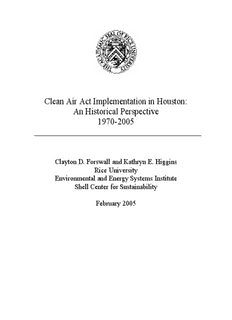
1955-1990 – The Advent of Air Pollution Control in the United States PDF
Preview 1955-1990 – The Advent of Air Pollution Control in the United States
Clean Air Act Implementation in Houston: An Historical Perspective 1970-2005 Clayton D. Forswall and Kathryn E. Higgins Rice University Environmental and Energy Systems Institute Shell Center for Sustainability February 2005 Preface The following report is a background paper written for the February 24th, 2005 Shell Center for Sustainability forum “Lessons Learned: Meeting the Houston Ozone Standards, 1970-2004.” This forum will attempt to answer four key questions: • What was the intent of the Clean Air Act and its subsequent regulations related to ozone control? • What were the key economic, scientific, social, political and regulatory challenges to the implementation of the Clean Air Act ozone requirements? • What were the lessons learned which either impeded or supported the implementation of the ozone requirements? • What improvements can be made to improve the SIP process? Both the report and the forum were generously funded by a grant from ExxonMobil Chemical Company. Copies of the report can be found on the Shell Center for Sustainability website in PDF format at www.ruf.rice.edu/~eesi/scs. The report was developed from May 2004 to February 2005 as a research project under the supervision of the Shell Center for Sustainability. The report was co-authored by Rice University graduates Clayton Forswall (’04) and Kathryn Higgins (’03), with assistance from Abigail Watrous (Rice ’04), Will Conrad (Rice ’05), and Sarah Mason (Rice ’06), a current Professional Master’s student at the Wiess School of Natural Sciences. This report does not represent new academic research, but serves to provide a summary of existing information on the history of ozone control in the Houston-Galveston Area. Our charge was not to offer conclusions or recommendations, but to supply a thorough historical background to panel members and forum attendees so that they may offer their own conclusions and recommendations. The report was compiled from an array of sources, including over 40 interviews with key stakeholders and experts from the industry, government, non-profit, health and academic sectors. A list of the interviewees and reviewers, as well as their title and affiliation, can be found in Appendix A. The report has also developed a Houston-Galveston Area Ozone Control timeline. We feel this timeline is important to understanding the chronology and interactions of different aspects of Houston ozone control. The timeline can be found in Appendix D. Previous drafts of this report were shared with all listed interviewees. i ii Acknowledgments We would like to thank ExxonMobil Chemical Company for their generous support. Specifically, we wish to thank Dave Sigman, Doug Deason, and Bruce Barbre. We would also like to thank the following people for their time and effort in the interview and review process: Dave Allen, Ramon Alvarez, Jed Anderson, Victor Ayers, Bruce Barbre, Pam Burger, Craig Beskid, Jim Blackburn, Dina Cappiello, Neil Carmen, Steven Cook, David Crossley, Walt Crow, Bill Dawson, Doug Deason, Guy Donaldson, Cyril Durrenberger, Lawrence Feldcamp, Richard Flannery, Victor Flatt, Kelly Frels, Monica Gaudet, Pam Giblin, John Hall, Winnie Hamilton, Meg Healy, Christian Holmes, Liz Hendler, Leslie Huska, Harvey Jeffries, Kelly Keel, Steven Klineberg, Matt Kuryla, Jim Lester, Brandt Mannchen, Gary Marfin, Ralph Marquez, Herb McKee, Chuck Mueller, Frank O’Donnell, Jay Olaguer, Karl Pepple, Tom Stock, Bill White, John Wilson, and Larry York. iii iv Table of Contents Preface……………………………………………..………………………………………i Acknowledgements………………………………………………………………………iii Lists of Figures and Tables..……………………………………………………………..vii Glossary…………………………………………………………………………………..ix Background Paper Introduction……………………………………………………………..…………1 1955-1990 – The Advent of Air Pollution Control in the United States………….3 1990-2000 – Extensive SIP Revisions…………………………………………...24 Texas 2000 Air Quality Study and the 2000 SIP Revision………………………43 2002-2004 – HRVOC Controls………………………………………………….64 Endnotes………………………………………………………………………………….69 Appendices Appendix A: Interviewee and Reviewer List……..……………………………….I Appendix B: NO tpd Reductions of December x 2000 SIP Control Measures…..………….…….………………………………….II Appendix C: TexAQS 2000 Findings Accelerated Science Evaluation of Ozone Formation in the Houston-Galveston Area……….……………………………...……….…...VII Appendix D: Timeline………………………………Please see separate document v vi List of Figures and Tables Figures Figure 1: Conceptual Map of Photochemical Model ………...……………………29 Figure 2: Eulerian (fixed grid) Modeling Approach…………………………….....30 Figure 3: One-hour Peak Ozone Concentrations and Number of Monitors Recording One-hour Ozone Concentrations > 125 ppb….....44 Figure 4: Eight-hour Peak Ozone Concentrations and Number of Monitors Recording Eight-hour Ozone Concentrations > 85 ppb………………….45 Figure 5: East-west Vertical Cross Section of Ozone Concentration Across Houston Obtained by NOAA Environmental Technology Laboratory’s Airborne Ozone LIDAR on 8/30/00……………………….46 Figure 6: COAST monitored ozone levels and modeled ozone levels……………..48 Figure 7: Annual Days Exceeding Federal One-Hour Ozone Standard ...…………50 Figure 8: Comparison of O Production in 5 Cities………………………………..64 3 Figure 9: 5 City Comparison of Hydrocarbon Reactivity………………………….64 Figure 10: Ozone Production Rates………………………………………………….64 Tables Table 1: Comparison of Air Pollution Strategies………………………………….13 Table 2: Elements Required by Phase I Rate-of-Attainment Demonstration Plans……………………………………………………..37 Table 3: May 6th 1998 SIP Revision Elements ……………………………………41 , Table 4: October 27th, 1999 SIP Revision Elements………………………………41 Table 5: April 19th, 2000 SIP Revision Elements…………………………………42 Table 6: Major Objectives of TexAQS 2000……………………………………...43 Table 7: Hydrocarbons and Reactivities…………………………………………..57 Table 8: 2001 SIP Revision……………………………………………………….60 vii viii
Description: